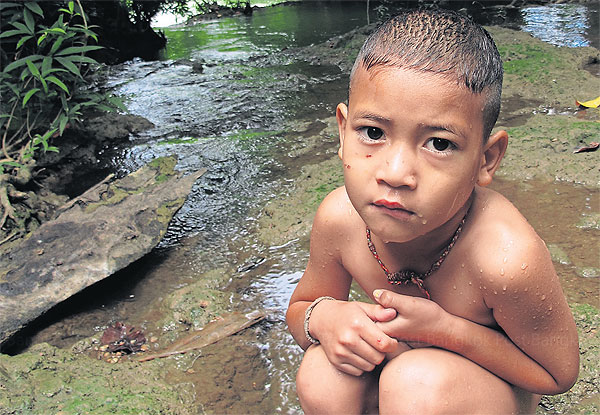Lower Klity Creek village is a magical, almost idyllic place. It's home to some 400 ethnic Karen people, in a part of Thailand known for its national parks and scenic waterfalls. The creek meanders out of the jungle, through the hundred or so homes that make up the village and down to a large reservoir.

A boy takes a rest after swimming in the lead-laden Klity Creek in a national forest in Kanchanaburi province. Despite a court order two years ago, the Pollution Control Department has not started cleaning up the creek. Intarachai Panitchakul
Long ago, local villagers erected a sign beside a small cascade of the stream, calling the place "Waterfall of the daughter of the mountain". "Daughter of the mountain" is an old phrase to describe women from ethnic minorities.
But when I visited in the middle of this year, one letter on the sign had been altered, changing the sign to read: "Tears of the daughter of the mountain." That's apt — because Klity Creek is now also one of the most heavily polluted industrial sites in all of Thailand. Eleven kilometres upstream is a former lead-processing factory. The factory, which started its operations in the mid-1960s, was ordered to close in 1998. But its toxic legacy remains.
To this day, residents of lower Klity Creek continue to be exposed to toxic lead — as they have for decades. Many suffer the symptoms of chronic lead poisoning, such as abdominal pain, headaches, fatigue, and mood changes. Some children have been born with severe intellectual and developmental disabilities.
Many parents experience the mental anguish of knowing that they are raising their children in an environment that threatens their children's futures, without being able to avoid the source of the poisoning.
Thailand's environmental authorities have studied Klity Creek since 1998. They have repeatedly found high levels of lead. Yet, the main response to these studies has been to do more tests.
The Pollution Control Department (PCD), the government body charged with preventing and resolving pollution problems, explained their inaction as a strategy of "natural remediation"—essentially, waiting for Klity Creek to clean itself.
The department was silent on how villagers—constantly exposed to lead by drinking water or eating fish from the creek, or by eating food grown with creek water or cooked in lead-contaminated water, or breathing air or touching soil contaminated by lead dust — would be protected for however long it took for the creek and surrounding land to be naturally remediated.
So in 2003, a group of villagers took the government to court to demand a thorough clean-up of the site. On Jan 10, 2013, the Supreme Administrative Court handed down a remarkable judgement. The court found the PCD negligent for being too slow to clean up the creek. And for the first time in Thailand's history, a superior court ordered the government to clean up a toxic site.
But since the court ruling, the PCD's response has been more studies and no action. According to the schedule drawn up by the department shortly after the decision, actual clean-up activities should have started on May 1, 2014. Yet, six months later, no clean-up has begun.
As a result of increasing industrialisation and mineral extraction, Thailand faces rising concerns about the health impacts from pollution in numerous mining sites around the country, including Na Nong Bong in Loei province, Mae Tao in Tak province, Tap Khlor in Phichit province, as well as the Map Tha Phut industrial area in Rayong province.
In 2011, the Ministry of Natural Resources and Environment commissioned an environmental assessment of lead mines in Kanchanaburi, raising the possibility of Thailand reopening and further developing lead mining and the lead industry in the same area as Klity Creek.
Thailand should clean up Klity Creek and provide medical care to affected villagers before even thinking of expanding lead mining.
The people of Klity Creek rejoiced when they won their legal case, and for a moment the "tears of the daughter of the mountain" could be seen as tears of joy, with hope finally at hand for the clean-up of their homes and the creek that's so important to the village.
A plan for Klity Creek — comprehensive, detailed, and making allowances for inevitable disruptions to food and water sources — could provide an opportunity for the PCD to develop expertise in working with communities and conducting environmental remediation.
But two years later, that moment of joy has passed and the villagers fear they will be slowly forgotten as the world moves on. It now seems to be a game to see how long Thailand's environmental and health authorities can continue to ignore the courts. Unless Thailand confronts this toxic legacy, it risks repeating the same tearful tragedy.
Richard Pearshouse is a senior researcher with the health and human rights division of Human Rights Watch.